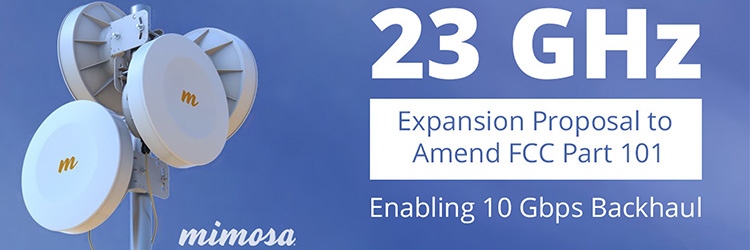Mimosa Advocates Expansion of 23 GHz Spectrum to the FCC – Enabling 10 Gbps Backhaul!
Given the severe shortage of spectrum available to WISPs to satisfy Internet demand in the U.S., Mimosa has proactively led the way in proposing new solutions to increase spectrum availability. In 2013, we petitioned the FCC for shared allocation of the 10.0-10.5 GHz band to expand available backhaul spectrum. Today we continue this effort by advocating for wider channels in the licensed 23 GHz band, urging the FCC to fully leverage this spectrum by significantly increasing efficiency and capacity.

Expanding Channels in the 23 GHz Band – Then to Now
Mimosa isn’t the first company to advocate for an expansion of the channel limits in the 23 GHz band. In 2011, the Fixed Wireless Communications Coalition (FWCC) petitioned the FCC in hopes of expanding channel allocations in the 23 GHz Part 101 band. This expanded use of the spectrum would have accelerated Internet accessibility and vastly increased backhaul capacity. Clearwire (later acquired by Sprint) also requested that the FCC “consider channel bonding rules for the 18 GHz and 23 GHz bands” to allow channels as wide as 150 MHz within each band. The FCC deferred action on these requests, but instead permitted wider channels in the 6 GHz and 11 GHz bands. While these changes provided some relief in capacity demands, many service providers, especially in suburban and rural areas, continue to suffer from poor backhaul alternatives due to heavy congestion in the most popular bands.
Advocating for Expansion of the 23 GHz Band
There are many reasons why expanding the channels in the 23GHz band is both necessary and overdue:
- Exponential growth in traffic: Back in 2002, shortly after the 23 GHz band plan took effect, worldwide Internet traffic was only 100 GB/second. By 2014, Internet traffic had grown to 16,144 GB/second, an annual growth rate of more than 50% over twelve years.
- Light use of the 23 GHz band: There are only 20,224 active 23 GHz licenses in the US, fewer than half the number as in the 11 GHz band, even though there is 2.4x as much spectrum. Moreover, the average link distance is shorter at 23 GHz, permitting much greater density of deployment. Widening the channels at 23 GHz will encourage operators to better utilize this national resource.
- Wider channels serve public interest: WISPs are often limited in the service speeds they can offer due to backhaul constraints. With 23 GHz radios operating at 10 Gbps, even subscribers in remote areas can enjoy the benefits of speeds previously only available to fiber subscribers.
- 5 GHz is congested: Unlicensed bands are critical for last mile Point-to-Multipoint and short range Wi-Fi use, and every day this precious spectrum becomes more saturated. Meanwhile, WISPs, who commonly use 5 GHz for backhaul to meet cost and distance requirements, struggle to get the bandwidth necessary to support consumers and businesses. Given the very high cost of deploying fiber, advancements are needed to deliver fiber-like speeds using affordable wireless backhaul technology. We see this problem as a spectrum and affordability gap for WISPs as they move to meet capacity demands in suburban and urban areas.
Collectively, these factors create an urgency for the FCC to act now.
Mimosa’s Vision – 10 Gbps Backhaul
Mimosa is pleased to support the petition to modify the rules governing the 21.2 – 23.6 GHz band to expand the current 50 MHz maximum channel width, with specific proposals for 80 MHz, 160 MHz and 320 MHz channels. Using advanced MIMO technologies and non-contiguous channel aggregation techniques, we believe the 23 GHz band can deliver significant capacity gains at greatly reduced costs for service providers and consumers.
Mimosa believes that a higher efficiency standard will enable high performance radios to leverage the wider channels while mitigating interference through better spectrum utilization. Since wider channels, with a higher efficiency standard, will give operators the opportunity to provide much higher data throughput than is currently possible in this band, ISPs can realistically begin to offer 10 Gbps service – speeds which match that of fiber.
How Can I Help?
We, as a community of Internet users, can support the efforts to expand spectrum availability by commenting to the FCC on proceeding RM-11610 to modify the rules governing the 23 GHz band to permit wider channels and to increase the payload capacity requirements. By simply applying the same techniques successfully used in the 6 GHz and 11 GHz bands to the 23 GHz band, we can meet the demands of tomorrow’s Internet users, use our resources more economically, and allow for much greater data throughput overall.